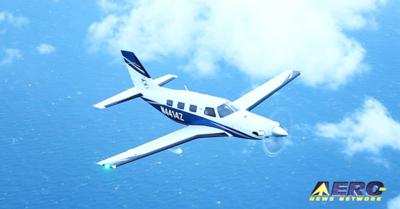The Calculated Descent Rate During The Final Portion Of The Turn Was More Than 17,000 Ft Per Minute
Location: Marianna, AR Accident Number: CEN24FA179
Date & Time: May 12, 2024, 19:56 Local Registration: N241PM
Aircraft: Piper PA46-500TP Injuries: 2 Fatal
Flight Conducted Under: Part 91: General aviation - Personal

On May 12, 2024, about 1956 central daylight time, a Piper PA46-500TP airplane (file photo, below), N241PM, was substantially damaged when it was involved in an accident near Marianna, Arkansas. The pilot and passenger were fatally injured. The airplane was operated as a Title 14 Code of Federal Regulations Part 91 personal flight.
The pilot filed an instrument flight rules flight plan from the Pensacola International Airport (PNS), Pensacola, Florida, to Batesville Regional Airport (BVX), Batesville, Arkansas. A review of flight track data provided by the Federal Aviation Administration (FAA) revealed that the flight departed PNS about 1721, turned to the northwest, and climbed to flight level (FL) 280. The airplane’s course was a direct line to BVX. About 1945, the pilot began a descent out of FL 280. About 1955, The airplane entered a rapid descent and spiraling right turn. The airplane’s last observed track was at 1956:12. The calculated descent rate during the final
portion of the turn was more than 17,000 ft per minute. The airplane’s fuselage came to rest about 0.1 nm northwest of the last recorded position of the airplane.
The pilot reported continuous moderate chop to air traffic control while descending through FL 240. Simultaneous loss of communication and radar contact occurred at 7,800 feet. An alert notification (ALNOT) was issued at 2006. The wreckage was located about 2300 in a sparsely populated agricultural area. The fuselage came to rest on a 010° heading. The left wing was detached at the wing root and was found near the fuselage in two pieces. The inboard portion of the left wing was found about 30 ft and 281° from the main wreckage, and the outboard portion of the left wing was found about 80 ft and 353° from the main wreckage. The inboard portion of the right wing was fractured at the wing root and found partially under the fuselage. The engine was attached to the engine mount and embedded in the ground. An odor consistent with jet fuel was present.
The left horizontal stabilizer, vertical stabilizer, rudder, elevator, right aileron, right flap, and the outboard portion of the right wing were not located at the accident site. A search for the missing components utilizing a state police drone was conducted. No additional components were found during this effort. Additional search efforts are underway. The main spar box structure was separated at the left and right wing roots. The spar box was pushed aft on the right side during the impact sequence. The spar box displayed upward Ushaped bending of about 12 inches along the outboard span of each side and was relatively unbent along the center span, consistent with positive loading. Black witness marks consistent with leading edge wing de-ice boots were found on the right side of the aft fuselage.

Flight control continuity was established to the extent possible with the condition of the wreckage. All observed separations were consistent with impact or overload damage. No anomalies were found with the flight control system. The engine was found embedded in soft mud and remained attached to the engine mount. The exhaust duct exhibited torsional buckling consistent with torque production. All four propeller blades remained attached to the propeller hub. The blades exhibited bending progression from forward to aft in the direction of rotation consistent with thrust production. Additionally, rotational scoring and polishing was observed on each of the blades. The landing gear was found in the retracted position. The flap actuator displayed one thread exposed on the jackscrew, consistent with a flap retracted position. The pitot heat switch in the overhead switch panel was found in the ON position. Both pitot tubes were tested, and produced heat when an electrical source was applied.
Two small dogs were reportedly on board the airplane but were not located on scene or within the wreckage.
The airplane was recovered to a secure facility for further examination. A review of weather data revealed that Graphical Airman's Meteorological Information (GAIRMET) for occasional moderate turbulence between FL 210 and FL 410 was depicted over northeast Arkansas and Tennessee. Convective Significant Meteorological Information (SIGMET) had been issued over extreme southern Arkansas, western Mississippi, Louisiana, and eastern Texas for an area of embedded thunderstorms. An analysis of weather soundings indicated strong vertical wind shears between 24,000 ft msl and 12,000 ft msl with a high possibility of moderate or greater turbulence around the time of the accident.
 ANN's Daily Aero-Linx (04.30.25)
ANN's Daily Aero-Linx (04.30.25) ANN FAQ: Turn On Post Notifications
ANN FAQ: Turn On Post Notifications Classic Aero-TV: Agile Aeros Jeff Greason--Disruptive Aerospace Innovations
Classic Aero-TV: Agile Aeros Jeff Greason--Disruptive Aerospace Innovations Aero-News: Quote of the Day (04.30.25)
Aero-News: Quote of the Day (04.30.25) ANN's Daily Aero-Term (04.30.25): Expedite
ANN's Daily Aero-Term (04.30.25): Expedite




